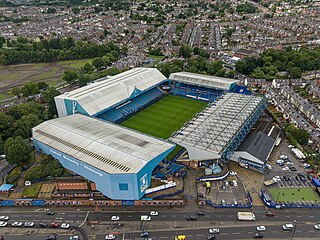
Hillsborough Stadium is a football stadium in Sheffield, England. It has been the home of Sheffield Wednesday since opening in 1899.

Lincoln City Football Club is a professional association football club based in the city of Lincoln, Lincolnshire, England. The team competes in EFL League One, the third level of the English football league system.

Valley Parade, known as the University of Bradford Stadium for sponsorship reasons, is an all-seater football stadium in Bradford, West Yorkshire, England. Built in 1886, it was the home of Manningham Rugby Football Club until 1903, when they changed code from rugby football to association football and became Bradford City. It has been Bradford City's home since, although it is now owned by former chairman Gordon Gibb's pension fund. It has also been home to Bradford for one season, and Bradford Bulls rugby league side for two seasons, as well as host to a number of England youth team fixtures.

Adams Park is an association football stadium in High Wycombe, Buckinghamshire, England. Built in 1990, it is the home ground of the local Wycombe Wanderers in League One. It was also leased from 2002 to 2014 to the rugby union club London Wasps from Aviva Premiership, and from 2016 to 2020 to the Reading F.C. Women football club. From the 2003–04 season to the 2005–06 season, the stadium was officially called Causeway Stadium, named after its sponsor Causeway Technologies.

Kingsmeadow is a football stadium in Norbiton, Kingston upon Thames, London, which is used for home matches by Chelsea Women and Chelsea Development Squad. It was formerly the home of Kingstonian and AFC Wimbledon and has a capacity of 4,850, with 2,265 seats.
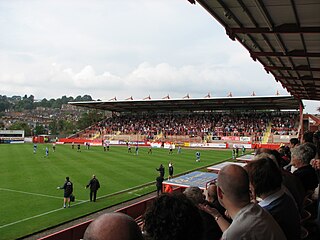
St James Park is a football stadium in Exeter and is the home of Exeter City FC. The stadium is served by the St James Park railway station, which is right next to the ground. It has been adopted by the club who contribute to its upkeep, under the community rail scheme, and its railings have been painted in the red and white of Exeter's strip.

London Road, currently known as the Weston Homes Stadium for sponsorship reasons, is a multi-purpose stadium in Peterborough, England. The stadium is in Fletton, south of the River Nene. It is currently used mostly for football matches and is the home ground of Peterborough United. The stadium holds 12,965 and was built in 1913, though the present ground bears no resemblance to the original following several periods of redevelopment.

Roots Hall is a football stadium located in Southend-on-Sea, Essex, England. The stadium is the home ground of the Vanarama National League team Southend United. With a capacity of 12,392, Roots Hall is the largest football stadium in Essex. During the early 21st century, there was lengthy discussion of a new 22,000 seat stadium at Fossetts Farm, but a change of ownership in 2023 seemingly ended prospects of that development.

Gresty Road or the Alexandra Stadium, currently known as the Mornflake Stadium for sponsorship reasons, is a football stadium in Crewe, Cheshire, England. The home ground of Crewe Alexandra, it has an all-seated capacity of 10,153.
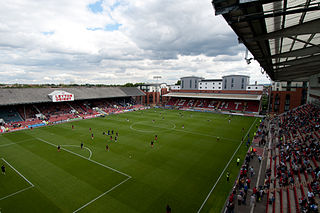
Brisbane Road, currently known as the Gaughan Group Stadium for sponsorship reasons and originally known as Osborne Road, is a football stadium in Brisbane Road, Leyton, East London, England. It has been the home ground of Leyton Orient since 1937, before which it was the home of amateur football team Leyton, who moved to the Hare and Hounds ground. Since 2022 it has also been home to Tottenham Hotspur Women. The highest attendance at the ground was 34,345 for the visit of West Ham United in the 1964 FA Cup. It has hosted a number of England U-16 and England women's team matches. It hosted the 2007–08 FA Women's Premier League Cup final. It was also home of the Tottenham Hotspur Reserves. In 2012 Brisbane Road hosted the final of the inaugural NextGen series, a competition for the academy sides of elite clubs.
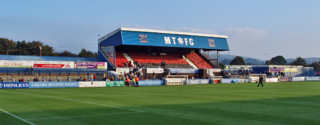
Moss Rose, known as The Leasing.com Stadium for sponsorship reasons, is a football stadium in Macclesfield, Cheshire, England, which is the home ground of Macclesfield F.C., and the former home of Macclesfield Town, a club wound up in September 2020. The stadium, 1 mile (1.6 km) south of the town centre, is on the west side of the A523 London Road. The capacity is currently restricted to 4,720 by Cheshire East Council. It was built in 1891, making it one of the oldest grounds in England.
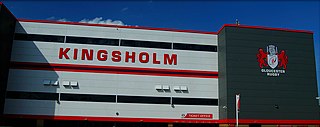
Kingsholm Stadium is a rugby union stadium located in the Kingsholm area of Gloucester, England, and is the home stadium of Gloucester Rugby. The stadium has a capacity of 16,115. It is sometimes nicknamed 'Castle Grim', after the estate where the stadium is built. The new main grandstand, opened in 2007, is an all-seated 7,500 capacity stand along the south touchline. It is currently sponsored by Malvern Tyres.
Cherrywood Road, known as the Saunders Transport Community Stadium for sponsorship purposes, is the ground of Farnborough F.C. and the former home of Farnborough Town F.C. before the club went out of business in 2007. It lies in the town of Farnborough, Hampshire. The capacity of the ground is 7,000, with 1,927 seats. Up to the mid-1970s Farnborough Town F.C. had played at Queens Road but moved due to the lack of facilities. Cherrywood Road was newly built with the help of a local company Worldwide Carpets.
Whaddon Road, known as the Completely-Suzuki Stadium for sponsorship reasons, is a football stadium in Cheltenham, England. It is the home ground of Cheltenham Town F.C. It has a total capacity of 7,066, with a mixture of seating and terracing. The ground's official name was the Victory Sports Ground until April 2009 when it was renamed the Abbey Business Stadium through a sponsorship deal. It was announced on 13 July 2015 that the club had agreed a three-year deal to rename the stadium The World of Smile Stadium, but the deal ended after only one year and the stadium was renamed LCI Rail Stadium in 2016–17, before being named "Jonny-Rocks Stadium" in 2018–19, and "Completely-Suzuki Stadium" in 2022.

The Northolme is a football ground in Gainsborough, Lincolnshire, England. It is the home ground of Gainsborough Trinity, it has a capacity of 4,304, of which 504 is seated.

The Recreation Ground, currently known as The EBB Stadium at The Recreation Ground for sponsorship reasons and informally known as The Rec, is a football ground in Aldershot, Hampshire, England. Football matches have been played there since 1927 when Aldershot was founded. The ground hosted league football between 1932 and 1992 when Aldershot were members of the Football League. Its current tenants Aldershot Town have used the ground since forming in 1992 and the ground once again hosted league football between 2008 and 2013.
Notts County Ladies Football Club was a women's football club based in Nottingham, England. They played their home games at Meadow Lane.

Damson Park is an association football stadium in Damson Parkway, Solihull, West Midlands, England. It was the new home of Solihull Borough following their departure from their original Widney Lane Ground. It is now the home of Solihull Moors, the club formed when Solihull Borough and Moor Green merged in 2007. They previously shared Damson Park with Birmingham & Solihull R.F.C. and also used to have an agreement that allows Birmingham City Reserves the use of the ground for their reserve games. The capacity of the stadium is 5,500.
The 2019–20 season is Lincoln City's 136th season in their history and their first season back in League One after being promoted as champions out of League Two in the 2018/2019 season. Along with League One, the club also participates in the FA Cup, EFL Trophy and the club has been eliminated from EFL Cup

Founded in 1884, Lincoln City F.C. won the Midland League in 1889–90, their first full season playing league football. They moved on from the Football Alliance to become founder members of the Football League Second Division in 1892, remaining there until they failed re-election in 1908. They won immediate re-election after winning the next year's Midland League, and would repeat this feat after failing re-election again in 1911 and 1920. Founder members of the Football League Third Division North in 1921, they won promotion as champions in 1931–32, but were relegated two seasons later. Crowned Third Division North champions again in 1947–48, they were relegated the next year, but would remain in the second tier for nine seasons after again winning the Third Division North title in 1951–52. Two successive relegations left them in the Fourth Division by 1962, where they would remain until Graham Taylor's title winning campaign of 1975–76.


















